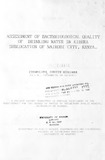| dc.contributor.author | Chemuliti, J K | |
| dc.contributor.author | Gathura, P B | |
| dc.contributor.author | Kyule, M M | |
| dc.contributor.author | Njeruh, F M | |
| dc.date.accessioned | 2013-06-19T14:01:48Z | |
| dc.date.available | 2013-06-19T14:01:48Z | |
| dc.date.issued | 2002 | |
| dc.identifier.citation | Chemuliti JK, Gathura PB, Kyule MM, Njeruh FM (2002). Bacteriological qualities of indoor and out-door drinking water in Kibera sub-location of Nairobi, Kenya. East Afr Med J. 2002 May;79(5):271-3. | en |
| dc.identifier.uri | http://www.ncbi.nlm.nih.gov/pubmed/12638814 | |
| dc.identifier.uri | http://erepository.uonbi.ac.ke:8080/xmlui/handle/123456789/36329 | |
| dc.description.abstract | To compare the bacteriological quality of out-house (tank or standpipe) water and in-house drinking water (storage containers) and determine the risk factors influencing it.
A cross-sectional study.
The study was carried out in Kibera slums located 7 km southwest from the Nairobi City centre.
Water samples from twenty outside tanks/standpipes and sixty from in-house water storage containers.
Pour plate method was used to enumerate total bacterial counts in water, while the multiple tube technique was used to determine faecal coliform (FC) and faecal streptococci (FS) numbers. A questionnaire and environmental observation were used to determine the risk factors influencing bacteriological quality of water.
The mean total bacterial counts (TBC) for out-house water was 46.6 per 100 ml while that for in-house water was 818.2 per 100 ml. Faecal coliforms were isolated from 7 (35%) standpipes and 57 (95%) in-house storage containers. The mean faecal coliform count was 93 and 103.4 per 100 ml for out-house and in-house water, respectively. The counts were significantly higher in the latter. Faecal streptococci were isolated from 2 (10%) standpipes and 37 (61.7%) in-house storage containers. The mean faecal streptococci counts were 35 and 65 per 100 ml for out-house and in-house water sources, respectively. Escherichia coli was isolated in 2 (10%) of out-house water and 30 (50%) of in-house. Of these, four were enteropathogenic, serotype 011 from one out-house water source and serotypes 011, 011, 0112ac from in-house water sources.
Bacteriological contamination of water at the source with a further deterioration between the collection points and homes was observed. A defective water delivery system and inadequate environmental sanitation were a potential source of contamination for out-house water. Scoops were a major source of contamination for stored water. | en |
| dc.language.iso | en | en |
| dc.title | Bacteriological qualities of indoor and out-door drinking water in Kibera sub-location of Nairobi, Kenya | en |
| dc.type | Article | en |

